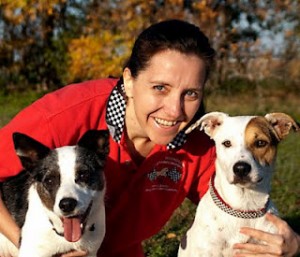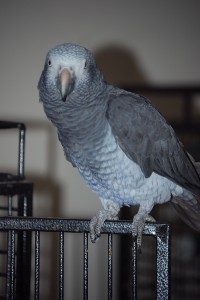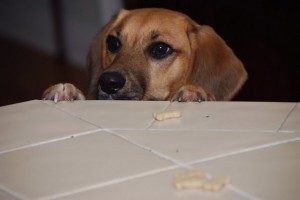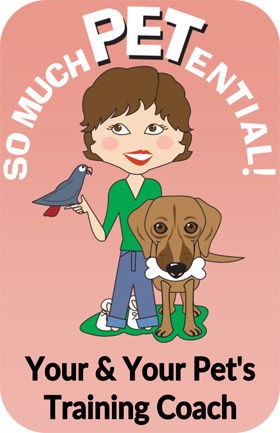Animals
This Parrot Loves His Bunny
NOTE: I have a new pet behavior blog located at http://www.SoMuchPETential.com/blog. Thanks!
I love this video because it reminds me so much of Chester. Ringneck parakeets have so much curiosity and such a zest for life.
Think You Have a Dumb And Stubborn Dog? Probably Not.
Note: I have a new pet behavior blog at http://www.SoMuchPETential.com/blog.
(one of my past columns from Hyde Park Living)
It was through a parrot behavioral analysis email listserve that I met Jeni Rivett. She is an Arizona-based agility dog trainer, sharing her home with three fully flighted birds and four energetic dogs. I still have one of her posts from years ago when she described how, on cue, all seven of her animals fly or run to their cages. What an amazing site, I remember thinking. When I wrote to her, she described in detail how she taught them.
Jeni, like other trainers with whom I respect and learn from, doesn’t train using ‘pack leader’, dominance-based methods. Although, like so many of us, she did try those other punishment based techniques first. What she and everyone who has ever taught animals (including the human kind) has learned, is that by far, positive reinforcement based training gives her the best results. Behaviors she teaches using positive reinforcement are stronger and done with much more enthusiasm because animals are eager to learn when they are rewarded for their actions. Additionally,  teaching in this way serves to build stronger relationships – and that’s something we all want.
teaching in this way serves to build stronger relationships – and that’s something we all want.
Take Sophie for example. The once unhappy dog housed in small quarters of a pet store who later was labeled stupid and stubborn, turned out to be excessively smart when her teacher began using different strategies. The problem – Sophie’s newly adopted mother, that would be Jeni, unwittingly took her to a place that trains police dogs to learn about obedience. They employed practices we’re all too familiar with like jerking the collar. In behavioral terminology, that is called positive punishment, and, as is the danger in using that type of method, Sophie quickly learned to hate training. Can you really blame her?
“I really just thought obedience wasn’t for Sophie,” Jeni said.
There’s a dynamic that happens a lot, Jeni explained. When an animal becomes non-compliant we tend to want to make them do what we want. But when the relationship is adversarial (whether just humans or humans and animals), it just doesn’t work. There are so many possible negative ramifications, aggression and lack of interest are just two.
It was by fluke that Jeni learned about agility training, training that is done with positive reinforcement instead. Suddenly Sophie was catching on, and fast. In two days, that dumb animal had caught on to everything. Everything. It has transformed Jeni’s teaching approach, and as a result, she lives with a house full of really smart companions.
Now Jeni sees her role as more of a team captain and collaborator, rather than a pack leader. “I work really hard to listen to my animals. If I’m having trouble training a behavior, I know there is good reason for it. As the teacher, I look at what I can do better to explain what I want. Maybe I’m not reinforcing my dog for what I want to see more of, maybe my timing is off for providing reinforcement, or maybe I’m asking for too much,” she said.
So, how would someone go about teaching a dog ‘not’ to do what we don’t want – like jumping on the plushy and very expensive sofa in the living room?
“Think about your goals,” Jeni advises. “If I had a dog I didn’t want on my couch, I’d realize he needs a comfortable alternative, otherwise we’d all be sitting on the floor.”
So, first step. Get your dog the most comfortable, plushy pillow or bed you can find and place it in the same room as the sofa you’d rather left to humans. Then get a nice supply of your pet’s all time favorite food or toy treats. Put the treats on the acceptable pillow and when your dog comes over, up the reward with extra human attention. Wow, it doesn’t get much better than that.
Your goal is to make being on that pillow the most totally awesome place to hang out because look at all the reinforcement your friend gets for being there, not to mention it’s sooo soft. Next time you see your dog on your sofa, instead of scolding him (remember punishment is bad for relationships and serves no teaching function), simply ignore him, go to his pillow and have a great time without him, playing with his favorite reward no less. How soon do you think it will be before he ‘chooses’ to go to the pillow instead because he associates it with so much that is positive? You can even put that on cue if you’d like.
Jeni’s dogs never get in trouble for being on her couch, they just get reinforced for being somewhere else. Instead of being punished for doing something wrong, they are rewarded for doing something that is acceptable.
“I’ve found that when I offer plenty of opportunities for reinforcement for everyone, the whole household is a more pleasant place to be,” she said. “There is no such thing as a dumb dog, they just need to be shown what they need to learn. If you can fix the trainer, you can fix the pet.”
Bird Training Is Quick When You Make It Fun
NOTE: I have a new pet behavior blog located at http://www.SoMuchPETential.com/blog. Thanks!
Steve Martin, president of Orlando-based Natural Encounters, is a phenomenal trainer of animals and teacher of people. I was fortunate to have traveled to Florida several years back for a weekend course taught by him and my mentor, Dr. Susan Friedman. Steve was also president of the International Association of Avian Trainers and Educators, of which I’m a member.
I love this video. Watch the African Grey on the left and how easily Steve shapes its behavior simply by reinforcing what Steve wants to see. And how eager the African Grey is to try and figure out what he needs to do to get that reward. That is the magic of positive reinforcement training. You create such an eagerness for your pet to want to learn.
Solving Pet Parrot Phobic Behavior – Positively
NOTE: I have a new pet behavior blog located at http://www.SoMuchPETential.com/blog. Thanks!
Note: This is a past column from my Hyde Park Living pet behavior column.
Every once in awhile you have the opportunity to read about my personal stories as they pertain to modifying pet behaviors in the most positive, least intrusive ways. I’ve been studying this for nearly four years now. Not only has it completely changed my relationship with my three parrots, I find it absolutely fascinating.
This month, I will focus on fear. With birds especially, I’ve often heard people talk of their pet’s sudden neurotic, phobic behaviors. Out of the blue, for no apparent reason, their loving companion will scream, lunge or try to escape  the hands that up until that moment had only been associated with positive things.
the hands that up until that moment had only been associated with positive things.
I know about this, unfortunately, from firsthand knowledge. My loving Barnaby Timneh African Grey, who normally would be very happy spending his entire day with his face pressed against mine (of course it would have to be with the occasional play break), would suddenly ‘out of the blue’ panic when he stepped onto my arm. He’d scream with horror in his voice, breathe heavily, and then take off. If you’ve ever experienced the unconditional love of an animal, you can probably understand it is completely heartbreaking when you are thrust into the portrayal of some evil monster – and you don’t even know why.
Each time it would happen with Barnaby, I’d have to go through a systematic desensitization plan to help him overcome his anxiety. Because we have a long history of trust, we were able to work through this fairly quickly, but my training taught me there had to be a reason for this reoccurring behavior. And there also had to be a way of eliminating or minimizing the frequency of it. Behavior, I know, doesn’t ever happen willy nilly. It is always triggered by something in the environment. And the consequences of that behavior are what either maintains, builds or extinguishes it.
Hmm. Actually it became fairly easy to figure out once I put on my behavior analysis hat.
There is a window in the birds’ room that faces the street. On sunny days, when a car drives past, the light that reflects from the metal and glass makes a brilliant pass from one wall to the next. A pretty scary demon to a Timneh teddy bear no longer than a ruler. If my neighbor parks her car in a certain spot at a certain time of day and Barnaby happens to be way up high, that same evil light hovers. Each time that Barnaby jumped on my arm, only to be terrified, that same ‘trigger’ light just happened to be coming from the street.
My mentor and teacher, Dr. Susan Friedman – a respected psychologist and behaviorist – helped me to understand. Purely based on my poor timing, in Barnaby’s mind, I got associated with the light. And that was not a good thing to be paired with.
Barnaby had two types of behaviors going on. One was an automatic, involuntary response to a bright light (panic scream, escape). In scientific terminology, this is called an unconditioned or respondent behavior because it wasn’t something that Barnaby learned in the way that he came to know stepping up generally meant only good things would follow. On the other hand, his stepping up behavior is most definitely learned. Scientists call that operant learning.
Now, think of the use of a clicker. The clicker in and of itself is meaningless to an animal. It only acquires value to that animal when a good trainer repeatedly pairs the sound with a treat. Then the click acquires reinforcing value.
This same type of association was going on with Barnaby, only it was a negative one. Being on my arm – something that had always given him positive reinforcement in the past – when the light (remember, something that causes an unconditioned fear response) came through the window, was being paired with that fear response. Just as the words ‘good boy’ have become associated with safflower seeds, his being on my arm had become associated with that awful light.
Once this became clear, working toward a solution really wasn’t that difficult. What I learned from Susan (and so many great people on Susan’s international parrot behavior listserve) is how to modify Barnaby’s environment so as to set him up for success. When I’m working from home, I try to remember to close their shade at a certain time. But if the shade is up, and there is that dangerous light outside (at least in his eyes), I absolutely will not pick him up. Instead, he’s learned to go inside his cage at that time. That one small adjustment has meant the difference between a pet who became instantly phobic of me – on a more frequent basis – to one who hasn’t exhibited those behaviors once since I figured it all out. So, it really wasn’t just some irrational fear after all.
This isn’t to say that something else in the future may pop up, that will cause that same fear response. Barnaby is a living being, and, as life goes, behaviors evolve all the time to adapt to the environment. But next time, I’m going to be better equipped to send those awful monsters packing so Barnaby can just focus on having fun.
ABC’s of Pet Behavior, Part Two
Note: Please visit my pet behavior blog at http://www.SoMuchPETential.com/blog.
(from my Hyde Park Living column)
Last month I explained the ABCs of behavior and we can use them as the most positive, least intrusive way of managing and modifying our pet’s behavior. This month I thought I’d show you a little how it works.
First, let me recap. Applied behavior analysis is a systematic approach to solving behavior problems by changing the environment in which the behavior occurs. It involves looking at the very specific behavior (such as a bird biting or screaming) and the related environmental context that signals and reinforces it. We ask, “What happened *immediately* prior to the behavior (antecedent) to set the whole ball rolling?“ And, “What happened *immediately* after the behavior to reinforce it (consequence)?“
I’m going to use the example of our family dog, Sam, who has an earned reputation for pawing my mom when we eat or standing with his two front paws on the table looking for a prize. For the purpose of this column, I will label that set of  observable behaviors as ‘bad table manners.’
observable behaviors as ‘bad table manners.’
The setting event for ‘bad table manners’ is our sitting around the table with food. The consequence may be any number of things…my mom trying to ignore him but sometimes hugging him, sometimes telling him he’s bad, sometimes giving him a treat. You get the picture?
Since I know under what conditions his behavior is highly predictable, I can decrease the value of that behavior with antecedent strategies. I can play rough with him just prior to our sitting down to get him tired and less motivated to have ‘bad table manners.’ I can (and always do) make him a foraging toy that he only gets before we eat and that keeps him busy for awhile. (I break up pieces of treats, and intertwine them in knotted plastic grocery bags that are then stuffed into a heavy rubber ball.)
Another thing I have done was teach him an alternative behavior (actually he knows a lot of behaviors) that, when we are sitting at the table, he knows in black & white terms that *if * he does that behavior next to me – which I chose as sitting or laying down – *then* he will get reinforced with attention and small pieces of food. (Okay, I admit I feed him some at the table but only when he is doing a behavior I taught him is acceptable.) At the same time, I have removed all positive consequences of his bad table manners (which meant when he jumps or paws, I simply turn my back and push my plate to the center of the table).
Guess which behavior he does more of now? Heck, if I were him and I REALLY wanted a taste off that plate, and knew the only sure fire way of getting a sample was to sit or lay down, I think I’d choose to sit or lay down too. And I’d do it pretty darned fast.
What is so wonderful about this is that punishment never had to be used, only empowerment. Sam has learned to succeed because I am clear cut in teaching him what I want him *to* do and because I make learning fun. Let me say that again. At every step along the way…learning is fun.
To read part one, please click here.















